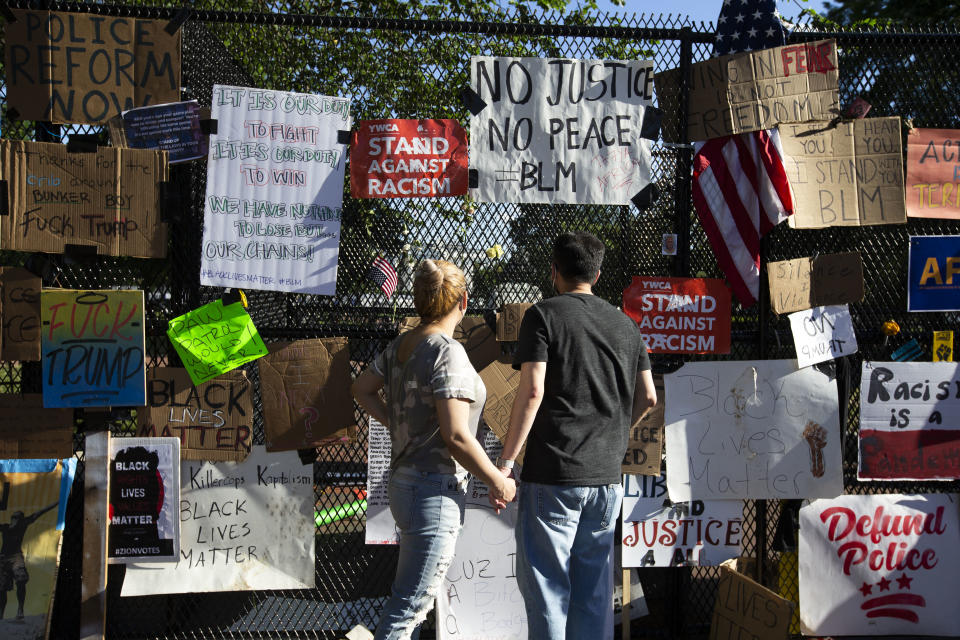'From a wartime barricade to a work of art': How a White House fence became a memorial to Black Lives Matter
WASHINGTON — The artwork covering the newly erected fence across from the White House emerged as many similar memorials have in the past: a spontaneous reaction to a place that has become a focal point for protests. Now, just a little over a week after going up, the chain-link fence is dotted with placards, paintings and artifacts.
Amid the poignant messages are birthday balloons, presumably for Breonna Taylor, who would have turned 27 last Friday but was killed by police in March; a placard spelling out, in detail, a proposed “George Floyd Act of 2020” to fight racism and police brutality; and an installation asking, “How many aren’t filmed?”
At the heart of the memorial, dead center at the intersection, is a solitary yellow wreath placed in front of a large Black Lives Matter banner, atop a note: “Treat people equal — just be human.”

The tall fencing was erected after protesters were forcibly removed from Lafayette Square on June 1 for a photo op by President Trump in front of St. John’s Episcopal Church, an act that sparked a nationwide outcry, including from the rector of the church. The fencing stretches nearly 2 miles around the White House and the surrounding area, including to the edge of the square.
The area bounded by the church and the square has taken on new importance as a focus for activity and resistance, most notably with a large street painting by Black Lives Matter demanding that D.C. Mayor Muriel Bowser “defund the police.”
On Friday, Bowser named the nearby intersection of H Street and 16th Street N.W. as Black Lives Matter Plaza, and demonstrators have transformed the imposing barrier around Lafayette Square into a memorial for black lives lost to police violence, bearing a large collection of signs and objects.
While the fence was scheduled to come down Wednesday, the Smithsonian confirmed that its curators are collecting some artifacts to preserve, and protesters have worked to move the artwork across the street, though it’s unclear what will happen in the long term.

As of Wednesday, curators from three of the Smithsonian museums, including the National Museum of African American History and Culture, had surveyed the memorial but hadn’t collected anything. The focus right now, according to a source familiar with the issue, has been speaking to people at the site, with the idea of potentially preserving some of the artifacts in the future.
For now, passersby gather to reflect, take photographs and engage in discussion. One visitor, who said she had been unable to attend the large weekend demonstrations, brought her young daughter early Tuesday morning to see the wall. She pointed to a spot underneath a tree where her daughter was able to leave a message.
“My daughter got to paint over there where they left the paint buckets,” she said. “I think that was pretty cool. You can just walk by and paint on the street.”
Now her daughter’s message joins a larger memorial that includes a quote from Lincoln’s Gettysburg Address: “That these dead should not have died in vain.”
Across the street, just steps from where Trump’s photo op took place, a few Black Lives Matter activists were working a refreshment station offering free snacks. One of them, Ryan Love, described the transformation of the fence “from a wartime barricade to a work of art” as a triumph for the movement.
When asked how long he and other activists would stay, he replied, “Till we’re not needed anymore. Till change.”
_____
Read more from Yahoo News:


